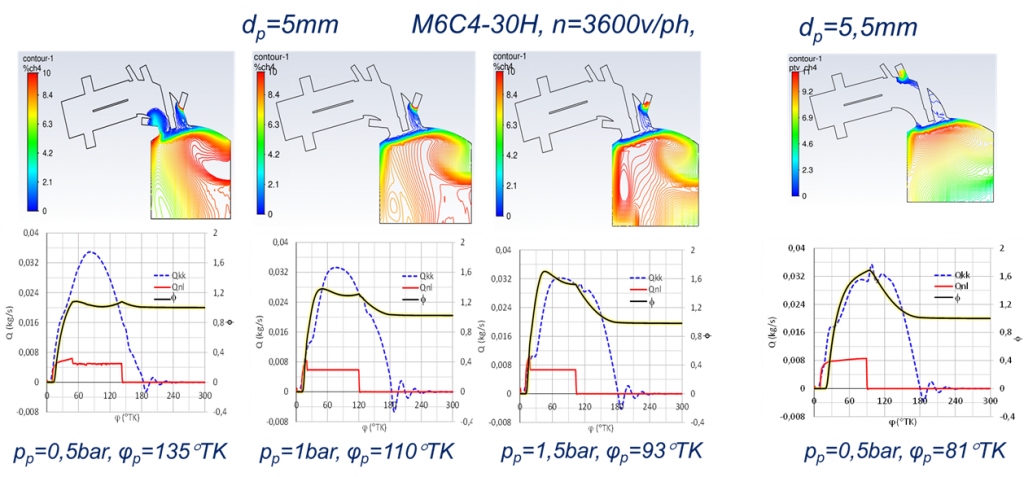Chúc mừng
Tân Tiến sĩ BÙI VĂN HÙNG
Thành viên nhóm GATEC
Đã bảo vệ thành công luận án Tiến sĩ trước Hội đồng chấm luận án Trường Đại học Bách khoa-Đại học Đà Nẵng ngày 8-7-2023
Congratulations to Dr. Bui Van Hung
A member of the GATEC TRT
Who has successfully defended his doctoral thesis before the Dissertation Evaluation Committee of the University of Science and Technology – University of Da Nang on July 8, 2023
Đề tài: TỰ ĐỘNG ĐIỀU CHỈNH HỆ SỐ TƯƠNG ĐƯƠNG VÀGÓC ĐÁNH LỬA SỚM ĐỂ NÂNG CAO HIỆU QUẢ CÔNG TÁC CỦA ĐỘNG CƠ BIOGAS-HYDROGEN
(AUTOMATIC CONTROL OFEQUIVALENCE RATIO ANDADVANCE IGNITION ANGLE TO IMPROVETHE PERFORMANCE OF BIOGAS-HYDROGEN ENGINE)
1. Nghiên cứu mô phỏng-Simulation




Giản đồ phun hỗn hợp nhiên liệu biogas-hydrogen (dp=5,5mm, pp=0,5bar,M7C3-20H, n=3600 v/ph)


2. Nghiên cứu thực nghiệm-Experiment





Kết luận:
1.Động cơ đánh lửa cưỡng bức truyền thống được chuyển thành động cơ sử dụng nhiên liệu khí biogas-hydrogen phù hợp với hệ thống năng lượng tái tại hybrid điện mặt trời-sinh khối nhờ ECU đơn giản. ECU gồm cảm biến xác định ĐCT, vi điều khiển được cài đặt chương trình điều khiển vòi phun và hệ thống đánh lửa.
2.Hàm lượng hydrogen là yếu tố chính ảnh hưởng đến góc đánh lửa sớm tối ưu của động cơ. Đối với động cơ tĩnh tại chạy bằng hỗn hợp biogas-hydrogen, góc đánh lửa sớm tối ưu phụ thuộc vào tỉ lệ H2/CH4. Ở tốc độ 3600rpm, góc đánh lửa sớm của động cơ chạy bằng hỗn hợp biogas-hydrogen nằm trong khoảng từ 16 độ đến 33°TK.
3.Ở một chế độ tốc độ động cơ cho trước, góc đánh lửa sớm tối ưu giảm 2°TK khi tăng 10% CH 4 trong biogas và giảm 3°TK khi tăng10% hydrogen tronghỗnhợp với biogas khi hàm lượng hydrogen pha vào biogas nhỏ hơn 20% khi sử dụng biogas thì hệ số tương đương tối ưu f=1,05
4. Khi pha20% hydrogen vào biogas thì hệ số tương đương tối ưu xấp xỉ f=1. Khi pha 20% hydrogen vào biogas thì công chỉ thị tăng trung bình16%, phát thải CO và HC giảm trung bình 30% nhưng phát thải NOx tăng gần 2 lần. Pha 20% hydrogen vào biogas là hàmlượng tối ưu để đạt được sự hài hòa giữa tăng hiệu quả công tác và giảm phát thải của động cơ
Các đóng góp mới:
►Chuyển đổi động cơ tĩnh tại sử dụng nhiên liệu xăng đánh lửa cưỡng bức thành động cơ tĩnh tại phun biogas-hydrogen, đánh lửa điều khiển điện tử.
►Xác định thành phần nhiên liệu hybrid biogas-hydrogen để đạt được sự hài hòa tính năng kỹ thuật và mức độ phát thải ô nhiễm của động cơ.
►Xây dựng giản đồ phun nhiên liệu và giản đồ đánh lửa động cơ sử dụng nhiên liệu biogas-hydrogen
►Kiểm soát quá trình phun nhiên liệu và góc đánh lửa sớm theo thành phần nhiên liệu và chế độ công tác của động cơ để nâng cao hiệu quả công tác của động cơ sử dụng nhiên liệu biogas-hydrogen
►Chế tạo ECU điều khiển động cơ sử dụng nhiên liệu khí linh hoạt, góp phần phát triển hệ thống năng lượng tái tạo hybrid năng lượng sinh khối-năng lượng mặt trời
Conclusion:
- The traditional spark-ignition engine has been transformed into a biogas-hydrogen engine, suitable for the solar-biomass hybrid renewable energy system, through a simple ECU. The ECU consists of sensors to determine the engine’s operating conditions, a microcontroller programmed to control the fuel injection system, and the ignition system.
- The hydrogen content is the main factor affecting the optimal advance ignition angle of the engine. For a stationary engine running on a biogas-hydrogen mixture, the optimal advance ignition angle depends on the H2/CH4 ratio. At a speed of 3600 rpm, the optimal advance ignition angle for an engine running on a biogas-hydrogen mixture ranges from 16 degrees to 33 degrees BTDC (Before Top Dead Center).
- At a predetermined engine speed condition, the optimal advance ignition angle decreases by 2°CA when the CH4 content in biogas increases by 10%, and it decreases by 3°CA when the hydrogen content in the mixture with biogas increases by 10%, provided that the hydrogen content blended with biogas is less than 20%. When using biogas, the optimal equivalence ratio is f=1.05.
- When blending 20% hydrogen with biogas, the approximate optimal equivalence ratio is f=1. Blending 20% hydrogen with biogas results in an average increase of 16% in indicated power, and a reduction of approximately 30% in CO and HC emissions, but an increase of nearly twice in NOx emissions. Blending 20% hydrogen with biogas represents the optimal content to achieve a balance between enhancing engine efficiency and reducing emissions.
New contribution of the thesis:
Ø Converting a spark ignition stationary engine fueled with gasoline into port injection biogas-hydrogen engine with an appropriate electronic control unit.
Ø Determine the biogas-hydrogen hybrid fuel composition to achieve the harmonization of technical features and pollution emission level of the engine.
Ø Construction fuel injection diagram and engine ignition diagram using biogas-hydrogen fuel.
Ø Control the fuel injection process and the advance ignition angleaccording to the fuel composition and working mode of the engine to improve the working efficiency of the biogas-hydrogen engine.
Ø Design and manufacture of an ECU for flexible gas-fueled engine, contributing to the development of a biomass-solar hybrid renewable energy system



















